CRESTED FORMS OF CACTI
W.Kalishev
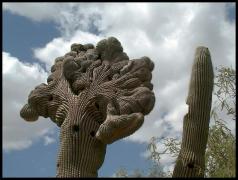 |
| Photo 1. |
There is no reliable information found concerning the time when crested forms of cacti appeared in Russia. Probably they appeared together with cacti on own roots. They say it happened 300 years ago. One can come to such a decision as crested forms live in nature (photo 1 - Raphael Carter - http://www.chaparraltree.com) ).
It can be proved by .Keeping and growing plants in room. by Doctor E. Regel, Part II. Second edition corrected and supplemented. St.Petersburg, 1890. The book was recommended to me by T. Klevenskaya, Moscow. It runs as follows: About 50 years ago numerous cacti were among favorite plants both for greenhouses and homes. Besides botanical gardens, trading gardeners also own rich collections, for instance, Haage et Schmidt in Erfurt.
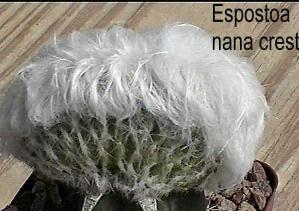 |
| Photo 2. |
The Imperial Botanical Garden of St.Petersburg, Russia, has a rich collection of cacti, as well as Peter P. Uspenskiy and Mr. Kutyakov. As for crested forms the book mentions Echinocactus Scopa Lk. Et Otto. Var. cristata has numerous crested offsets and is reproduced by grafting into different species of Cereus. It also contains certain information about Echinopsis multiplex Pfr var. cristata Salm which features flat crested stubble-covered stems. The most popular was Cereus peruvianus Tabern. They grew mostly ugly shortish forms with the stem dividing into short ugly branches and ribbed knobs. This form is also known as C. peruvianus monstrosus . an ugly cactus.
Probably the history of cacti is subject for future researches as well as the information about the cacti fanciers collecting crests. I would like to quote the letter by T. Klevenskaya: When I came to work in the Moscow State University Botanical Garden in 1956 there were lots of them there like in other collections. Among the fanciers of crested forms of the 60th - 70th I should mention Z.S. Tolkanova, Vladivostok/Sumi, Ukraine, N.S.Strizhak and P.S.Levchuk, Moscow, A.N.Evdokimova, Krasnodar region.
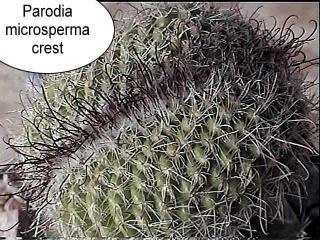 |
| Photo 3. |
Today you can find crested forms of cacti almost in every good collection. Fanciers not interested in these forms are very rare as well as true fans and experts. I can say only about 2 fanciers from Russia having quite a large number of crested forms of cacti. They are Vyacheslav Filippov, Moscow, and Vladimir Murashev, Chelyabinsk. The list of crests belonging to them you can see in the table.
There are several factors influencing the attitude towards crest:
- the difficulties of keeping, especially in winter; the difficulties of reproduction . they demand grafting which is
- a complicated procedure;
- the necessity of grafting stocks that are difficult to grow by yourself;
- the lack of seeds.
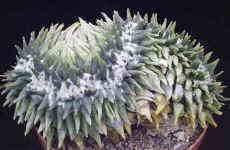 |
| Photo 4. |
One can judge about growing crested forms in foreign countries by books, the number of publications and photos in Internet. To be short all the sources of information are rather poor. One of the reasons is the absence of scientific explanation of the origin of crests. On the other hand it should serve as an impulse for discussing different versions and materials on the question, including absurd ones. Alas, they are very rare.
As for the photos in Internet they are one of the vivid proofs of interest toward crested forms. On of the most famous sites is
http://www.miles2go.com/crest.htm - Crested, Variegated, and Monstrose (photo 2 - 3) Cacti.
According to Vyacheslav Filippov this site (by Miles Anderson) contains the biggest number of crested forms in all the Internet. Besides you can see photos of crests at the following sites:
- http://www.living-rocks.com/hybridetc.htm (photo 4- Ariocarpus retusus, cristate )
- http://www.chaparraltree.com/photos/monstrose.shtm l Monstrose and Diseased Cacti (photo 1- saguaro-cristate-lg)
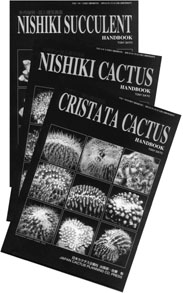 |
| Photo 5. |
I do not exclude that we are not familiar with some sites. This is why I address our readers and owners of sites: let us know their addresses. And another important detail for the owners. Please, permit us to publish your photos. We guarantee giving links to your sites.
And the last point on the question . the literature concerning crested forms of cacti. Does it exist, and where it is published? We know only one author Tsutomu Sato and three of his photo albums (photo 5).
Most Russian fanciers including the editors can not afford the albums that cost $120. People often ask how many crested forms fanciers have. There is no exact answer. I can only say that album "CRISTATA CACTUS" contains 600 photos of
crested forms. The Moscow magazine "Cacti and others" 4-2000 dedicated completely to crested forms has the list of crests including 580 names. The editors has the list of 90 names ("CULTIVAR" 1 - 2000. Thus, in total we have 670 names belonging to 110 genera. There are among them:
Acanthocalycium - 1, Acantholobivia - 1, Akersia - 1, Ancistrocactus - 1, Aporocactus -1, Ariocarpus - 9, Astrophytum - 14, Auscrocephalocereus - 2, Austrocylindropuntia - 4, Aztekium - 2, Backebergia -1, Blossfeldia - 1, Bolivicereus - 1, Borzicactus - 2, Brachycalycium - 1, Brasilicactus - 2, Brasiliparodia-1, Carnegia - 1, Cephalocereus -3, Cereus - 2, Chamaecereus -2, Cipocereus -1, Cleistocactus - 7, Cochemiea - 1, Copiapoa - 7, Coryphantha - 15, Cylindropuntia - 6, Discocactus - 10, Dolichothele - 3, Echinocactus - 4, Echinocereus - 38, Echinofossulocactus -1 Echinomastus - 4, Echinopsis - 18, Encephalocarpus - 1, Epithelantha - 11, Eriocactus - 3, Eriosyce - 3, Escobaria - 4, Espostoa - 11, Eulychnia - 1, Ferocactus - 12, Frailea - 7, Geohintonia - 2, Gymnocactus - 4, Gymnocalycium - 72, Haageocereus - 4, Hamatocactus - 4, Haseltonia - 1, Hertrichocereus - 2, Hil-dewintera - 1, Homalocephala - 1, Islaya - 2, Krainzia - 2, Leuchtenbergia - 2, Lobivia - 22, Machaerocereus - 1, Mamillopsis - 1, Mammillaria - 103, Marginatocereus - 1, Matucana - 2, Mediolobivia - 1, Melocactus - 3, Mila - 1, Monvillea - 3, Morawetzia - 1, Myrtillocactus - 3, Neochilenia - 1, Neolloydia - 2, Neoporteria - 9, Notocactus - 34, Obregonia - 1, Opuntia - 6, Oreocereus - 5, Oroya - 1, Pachycereus - 2, Parodia - 20, Pediocactus - 4, Pelecyphora - 5, Pereskia - 1, Phellosperma - 1, Philippicereus - 1, Pilosocereus - 8, Polaskia - 1, Pseudoespostoa - 2, Pseudolobivia - 3, Pygmaeocereus - 3, Pyrrhocactus - 2, Rebutia - 16, Reicheocactus -1, Ritterocereus - 1, Rooksbya - 1, Roseocactus -1, Sclerocactus - 3, Seticereus - 1, Setiechinopsis - 1, Soehrensia - 2, Solisia - 1, Stenocereus - 12, Strombocactus - 1, Submatucana -2, Sulcorebutia - 9, Tephrocactus - 2, Thelocactus - 10, Trichocereus - 13, Turbinicarpus - 10, Uebelmannia - 5, Weberbauerocereus - 2, Weingartia - 1.
The list of cristate forms of Cactaceae from collection of V.Murashov and from collection of V.Filippof
Symbolic notations:
* - it exists but is not reproduced;
+ - it exists and is reproduced;
1 - V.Murashev - Chelyabinsk;
2 - V.Filippov - Moscow.
| |
1 |
2 |
|
| Chamaecereus silvestrii |
* |
|
Mammillaria glassii |
| Cephalocereus senilis |
+ |
|
Mammillaria fuliginosa |
| Cipocereus bradei |
|
* |
Mammillaria hahniana |
| Cleistocactus strausii |
+ |
|
Mammillaria magallanii |
| Cylindropuntia subulata |
+ |
|
Mammillaria nana |
| Cylindropuntia vestita |
+ |
|
Mammillaria parkinsonii |
| Discocactus buenekeri |
|
* |
Mammillaria perezdelarosae |
| Discocactus horstii |
|
* |
Mammillaria pennispinosa |
| Echinocereus baileyi |
|
* |
Mammillaria prolifera |
| E. dasyacanthus |
|
+ |
Mammillaria saboae |
| E. brandegeei, |
|
* |
Mammillaria spinosissima |
| E.knippelianus kruegeri |
|
* |
M sp. tetracantha |
| Echinocereus pectinatus |
+ |
|
Mammillaria woodsii |
| Echinocereus. perbellus |
* |
* |
Monvillea spegazzinii |
| Echinopsis hybr (eyriesii) |
* |
|
Monvillea sp. |
| E. spec. paraguayensis |
|
* |
Morawetzia sericata |
| Espostoa ruficeps |
+ |
* |
Notocactus scopa "burgundi" |
| Espostoa nana |
|
+ |
Notocactus scopa (2 разных генотипа) |
| Epitelantha bokei |
|
* |
Oreocereus fossulatus |
| Eriocactus leninghausii |
|
+ |
Oroya borchersii (2 разных генотипа) |
| Euphorbia neriifolia babulina |
* |
|
Parodia aureispina |
| Euphorbia lactea |
+ |
|
Parodia microsperma |
| Euphorbia nearifolia |
* |
|
Parodia minuscula |
| Euphorbia obesa |
|
* |
Parodia scopaoides |
| Euphorbia piscidermis (2 разных генотипа) |
|
* |
Pachypodium lamerei |
| Euphorbia caput-meduisa |
* |
|
Pelecyphora valdesiana |
| Frailea castanea |
|
* |
Pelecyphora pseudopektinata |
| Gymnocal michan. friedr. rubra |
|
* |
Pilosocereus palmeri |
| Hamatocactus setispinus |
|
+ |
Pseudoespostoa nana |
| Haageocereus chrysacanthus |
* |
|
Pygmaeocereus densiaculeatus |
| Haageocereus versicolor |
|
+ |
Rebutia heliosa |
| Hildewintera aureispina |
+ |
|
Solisia pectinata |
| Krainzia longiflora |
* |
|
Sulcorebutia crispata |
| Lobivia anzistroflora |
* |
|
Sulcorebutia rauschii |
| Lobivia aurea |
|
* |
Thelocactus bicolor tricolor |
| Lobivia pampana |
|
* |
Turbinicarpus loph |
| Lobivia sp |
+ |
|
Turbinicarpus roseiflorus |
| Mammillaria bombycina |
|
* |
Turbin schwartzii |
| Mammillaria carmenae |
* |
|
Weberbauecereus johnsonii |





